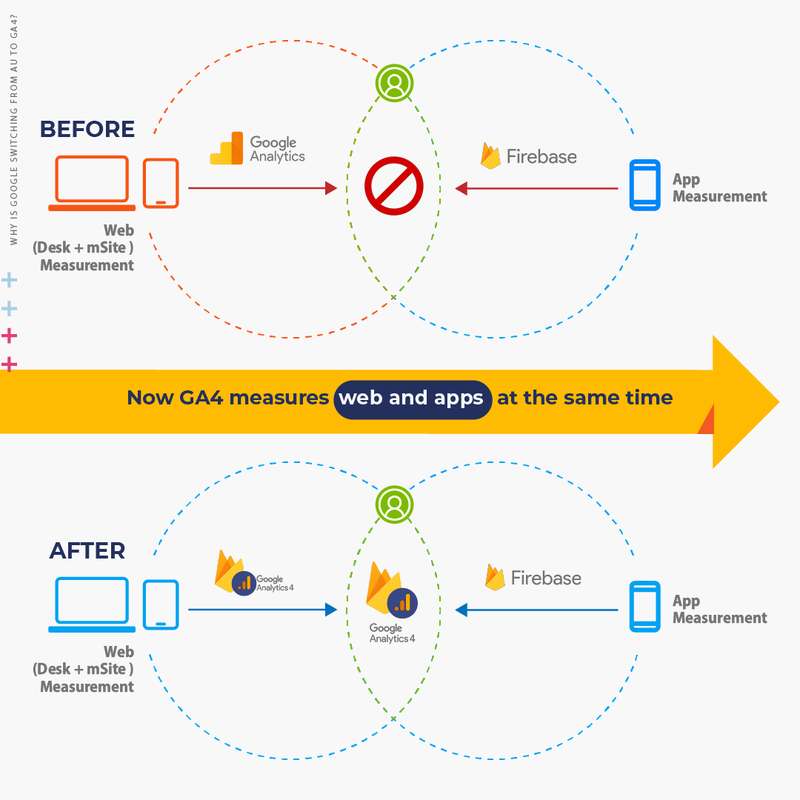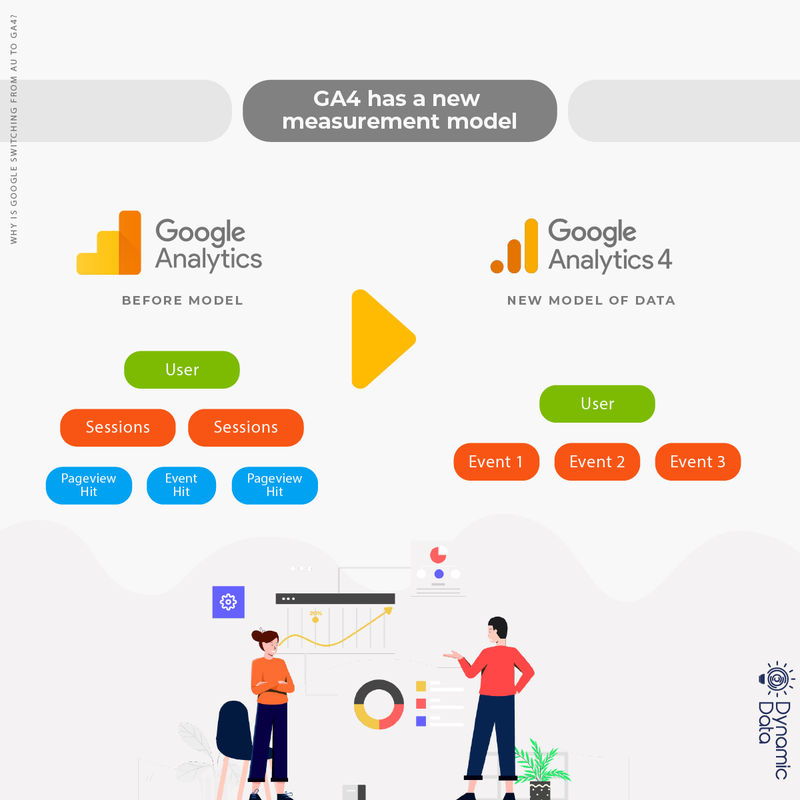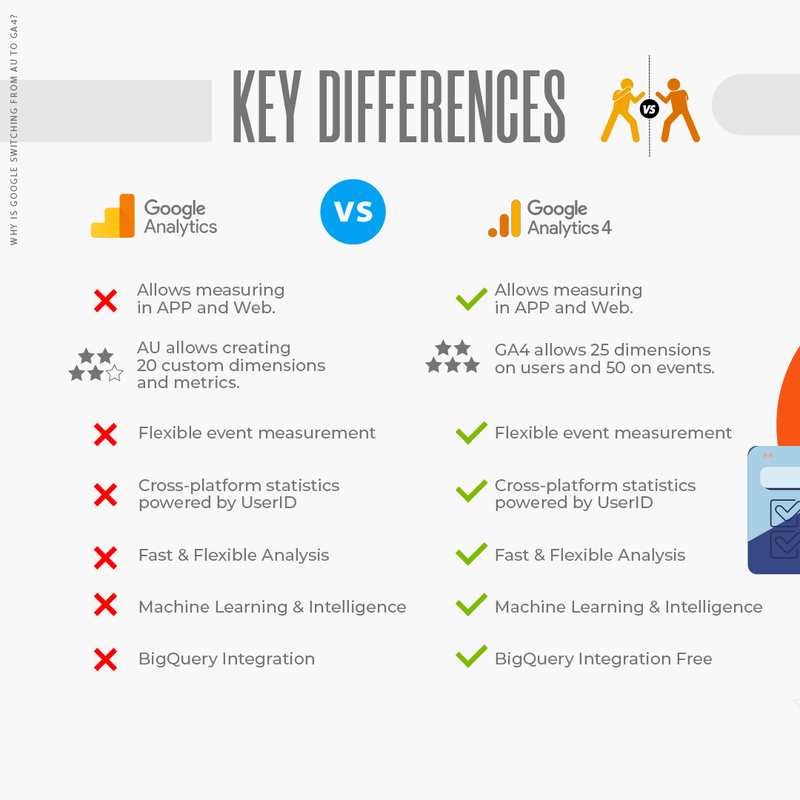

GA4 and the Future of Measurement
Google Analytics is the most popular web analytics service that has been operating since 2005. For nearly two decades, it underwent several transformations that made the tool evolve.
In 2019, Google launched GA4, which provides a more privacy-focused approach for tracking users across websites and applications without relying so much on first-party cookies. Google achieved this by improving machine learning, providing information on user engagement, and keeping their data anonymous.
GA4 wasn't built based on Google Analytics Universal but from Firebase. Firebase is a platform dedicated to developing mobile applications with the functionality of Firebase Analytics.
Why is Google switching from UA to GA4?
The General Data Protection Regulation (GDPR), which became enforceable in 2018, forced Google to shift from UA to GA4 to respond to the companies' commitment to privacy and gain control over managing user data.
Google Universal Analytics collects data by user, which made the tool gain popularity in recent years, but still leaves growing concerns on the GDPR infringement for websites.
GA4 is a future without cookies. The tool addresses these issues and assures companies and businesses that they can still track user engagement with the help of AI and machine learning.
Another strength of the tool's evolution is responding to the need to bring together the web world and the increasing utility of mobile devices. GA4 measures both the web and apps at the same time.

GA4: A New Measurement Model
GA4 and Universal have different measurement models. That is, they collect data differently.
The Universal measurement model is based on visits and sends information in hits of up to 4 types: page views, events, transactions, and time.
On the other hand, GA4 reporting is based on events. All hits are events or interactions that are associated with parameters containing data related to them. In GA4 we can see data flows from mobile apps and websites combined (Event-driven).

The current GA4 measurement model is much simpler, which brings several advantages when combining interactions to create segments or audiences.
With the new model, GA4 makes analyzing and understanding user behavior easier across multiple platforms, allowing businesses to create more effective marketing campaigns and improve overall customer experiences.
GA4 vs. Universal Analytics. Key Differences
In 2012, Google launched Universal Analytics to improve data collection. However, the platform is based on fundamentals not adapted to the current web.
GA4 was overhauled entirely and focused on tracking users across multiple devices to address this. With the new version, GA4 allows measuring the customer journey in both App and Web.
The data model of Universal Analytics uses sessions and page views, which were first developed more than 15 years ago, at a time when smartphones and tablets had not yet fully emerged.
While Universal Analytics only allows creating up to 20 custom dimensions and metrics, GA4 allows 25 dimensions focused on users and 50 focused on events.

With GA4, the term "bounce" and "bounce rate" disappears and is replaced by an engagement metric.
GA4: Other benefits and advantages
- Flexible Event Measurement
GA4 properties use a much more flexible event-based model that allows for the customization of measurements. Automatic events in GA4 collect data without the need for further configuration.
You can also automate the tagging of some events with enhanced measurements without any additional coding.
Measure more events from the get-go, such as downloads, video views, and more, with just clicking a button in a property.
- Cross-platform statistics powered by UserID
GA4 focuses on the customer journey across devices and platforms, providing a complete picture of how users interact with content. It enables measuring a sale that begins on mobile and concludes on the web.
- Fast & Flexible Analysis
The analysis offers more detailed techniques and deeper exploration capabilities to improve understanding of how people interact with a site and use that knowledge to deliver better experiences and achieve business goals.
New techniques and reports are available, including enhanced real-time reporting, exploration, funnel analysis, and roadmap analysis through the Analysis Hub.
- Machine Learning & Intelligence
Intelligence helps make Analytics data meaningful, accessible, and actionable for all businesses.
- View automatically surfaced insights such as anomalies, unexpected behaviors, recommended insights, and more.
- Ask questions about your data.
- Set up custom alerts on an hourly, daily, weekly, or monthly basis to be delivered via email or SMS.
- Apply machine learning to examine dozens of signals and determine which users will most likely generate conversions. Dynamically manage audiences to focus on those users.
Allows for reduced internal resources and costs to understand your data better.
Universal Analytics used the Last Click attribution model by default, which took into account the last interaction prior to the conversion.
GA4 introduces the new Multichannel Data-Driven attribution model, which considers all the clicks along the user paths until they complete a conversion.
In other words, this attribution model uses machine learning to distribute the value of each conversion. This tool is continuously improved, and the models automatically adapt to changes in the performance of different touchpoint categories.
- BigQuery Integration
The synchronization of Universal Analytics with the Google BigQuery platform was only possible with the 360 version; now, it is available for free using GA4.
BigQuery is a large enterprise data warehouse for analyzing information, creating reports, and performing SQL queries. With BigQuery, you can see the raw data extracted by Google Analytics and make more precise queries about what matters most to the business.
Why migrate to GA4 as soon as possible?
Google Analytics 4 will be the future data source for analytics. Using its new features and functionalities today will allow you to stay ahead of the market and have a long-term strategy.
The modularity and flexibility of Google Tag Manager make it easy to build your Google Analytics 4 implementation while maintaining your Universal Analytics implementation. In most cases, you can use many of the variables and triggers you defined to complete Universal Analytics to generate your custom Google Analytics 4 events and definitions.
GA4 will definitely replace Universal Analytics starting July 1st, 2023. However, before stopping using Universal, it is important to export all historical data. Google has already stated that it is not possible to migrate data from Universal Analytics to GA4 because the new platform uses different data models.
Are you ready to take the leap and switch to GA4?